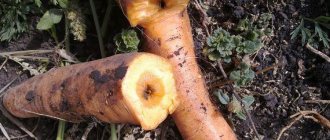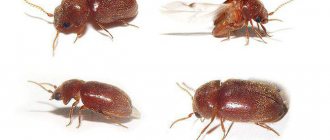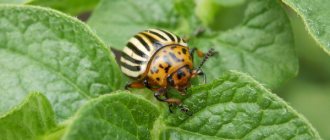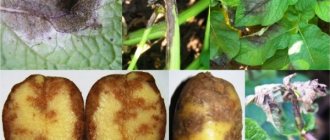Vegetable growing » Potatoes
0
2087
Article rating
Kira Stoletova
Potato scab among gardeners is often mistakenly considered the most harmless disease. She has no initial external signs of the development of the disease. Some varieties of potato scab do not manifest themselves at all at the initial stage. The whole danger of the disease lies in the fact that the infection accumulates in the soil and year after year reduces the quantitative indicators of the potato yield.
Potato scab and methods of combating it
Types of scab
The causative agents of potato scab are fungi and, depending on their type, there are several types of fungal diseases of vegetable crops:
- ordinary,
- black, or rhizoctonia,
- powdery,
- silver
Causes of infection
Among the main reasons contributing to the appearance of fungus:
- ingress of scab fungus onto healthy potato tubers from contaminated soil,
- acquisition of infected planting root crops,
- violation of crop rotation and planting vegetables in the same place,
- exceeding the standard content of the nitrogen component in the soil,
- increase in soil temperature above 20°C,
- weak acidity of the soil layer,
- non-compliance with the rules for fertilizing the land with organic matter - manure and compost.
Damage from scab
Scab on potatoes does not pose a threat to human health, but vegetables that can be eaten lose their nutritional value: compared to healthy tubers, their starch content is reduced by 2 times.
Affected potato tubers are poorly preserved due to the intensive development of rot in them. Infected root crops preserved during the winter period cannot be used as planting material. They are prohibited from being planted in the ground, as they are sources of soil contamination. The result will be an unhealthy potato crop, and fungus will take up residence in the soil.
Causes of appearance: why potatoes get sick
The main factor is the presence of conditions favorable for the growth and reproduction of the fungus. This is what causes the disease:
- overgrown soil;
- diseased planting material;
- long-term planting of potatoes in the same area;
- excessive use of nitrogen-containing fertilizers;
- high humidity and optimal soil temperature;
- alkaline soil promotes intensive growth of the microorganism;
- using manure as fertilizer before planting.
Common potato scab
Common scab is considered a common fungal infection in potato beds. Its causative agent of fungal origin, Streptomyces scabies, prefers to settle in dry sandy soil with a low to medium acidity level and activates its activity at temperatures ranging from 25°C to 28°C.
Signs
Among the main signs characteristic of ordinary potato scab:
- small brown lesions, sometimes with shades of red or purple,
- rough surface of potato tubers,
- the appearance of slightly noticeable mesh grooves on root vegetables.
In cases of severe infection of potato tubers, the lesions increase in size and subsequently begin to harden and crack. The result of the process is rotting of vegetables.
Spreading
An ordinary type of fungus practically does not damage other parts of the potato bush, spreading mainly through the tubers. During storage at low temperatures in basements, the common scab fungus falls into a suspended state, but does not die, which saves the harvest collected and stored until spring.
Potato varieties with thin red skins are most susceptible to the common variety.
Contributing factors for the development of fungus are:
- insufficient watering
- fertilizing the land with raw, not yet rotted manure,
- adding excessive amounts of limestone.
Prevention and treatment
You can fight scab
Against ordinary scab on potatoes, the land intended for planting vegetables is treated. In addition, gardeners try to plant fungus-resistant varieties, which include Kameraz, Domodedovo, Yantarny, Priekulsky, Zarechny.
As a preventive measure to combat scab on potatoes, it is recommended to spray planting tubers with drugs such as polycarbacin or nitrafen. An effective prevention method for developing immunity against the fungus is germinating seedlings in sunlight. Potato seedlings should be watered immediately after they are planted in the ground and watering should be completed when the stem reaches a width of 1.5-2.0 cm.
Preventive actions
- Scab pathogens are resistant to unfavorable climatic conditions, so they live in the ground for more than 4 years. Therefore, it is necessary to begin the fight against the disease with preventive tillage.
- These fungi primarily live in alkaline soils, so you should not use wood ash as a top dressing. Nitrogen fertilizers provoke the development of fungi, so the amount of preparations applied to the soil should be minimal. You should also not use fresh or partially rotted manure as a top dressing.
- To improve soil fertility and reduce the risk of scab, use fertilizers that contain potassium, phosphorus, copper and bromine. Water-soluble manganese and humus are also used as fertilizers.
Important!
To acidify alkaline soils, they can be spilled with a solution of ammonium sulfate (2 tablespoons of the drug per bucket of water).
If the harvested crop contained tubers affected by scab, then it is not advisable to plant potatoes in this area for 5 years
. For preventive purposes, the soil needs to be treated. It is recommended to plant green manure on the site, and before the onset of frost, dig up the site using a spade.
Powdery potato scab
Unlike the common variety of fungus, which prefers dry soil, powdery scab is a consequence of the action of the pathogen Spongospora subterranean. The fungus settles in waterlogged soil and can remain active for up to five years. The optimal conditions for its appearance are considered to be temperature limits from 10°C - 12°C.
Signs
Among the main external symptoms of the disease description characteristic of the powdery variety:
- covering the stems with white growths,
- the appearance of multiple red-brown warty growths of different sizes on potato root crops.
Spreading
Powdery scab affects both tubers and plant stems, mainly their lower part. Fungal pathogens are transmitted through organic residues preserved in the soil, but can also spread by air. Damaged tubers usually dry out during storage, but with high humidity in the room they begin to rot.
Factors contributing to the spread of the powdery form of the disease are rain.
Prevention and treatment
Among the potato varieties resistant to this type of fungal disease are Cardinal, Majestic, and Yubel. In order to prevent against powdery fungus, gardeners often soak the grown seedlings in a formaldehyde solution for 5-7 minutes before planting them in soil, subsequently covering them with a tarpaulin for several hours.
Where does the disease come from and how does it develop?
The causative agent of scab is radiant fungi (actinomycetes). They enter the soil along with organic residues. In conditions favorable for their life and development, mushrooms actively reproduce, approaching potato plantings. A certain temperature regime, humidity and soil composition are important for them.
Soil with the following indicators is most susceptible to contamination:
- soil with a slightly alkaline reaction and acidity pH - from 6.1 to 7.4;
- soil with a temperature of 12-15 degrees Celsius (for black scab), 22-24 degrees Celsius (for ordinary scab);
- soil, well loosened and moistened (humidity more than 55%);
- soil fertilized with fresh manure, lime or wood ash;
- soil with a high content of microelements nitrogen and calcium, with a lack of boron and manganese.
When artificially liming the soil, you should take half of the recommended norm (5-8 kilograms per 100 square meters), since lime activates the vital activity of the fungus and promotes its active reproduction.
Black potato scab
The causative agent of black potato scab is the fungus Rhizoctonia solani, which is activated at temperatures from 16°C to 18°C. He prefers high humidity, which is about 80-100%. The fungus develops in loamy soil.
Signs
The main signs of damage to a vegetable crop by the black variety are black or dark brown spots of damage that appear on the surface of root crops. Over time, they merge into extensive foci. Often, inexperienced gardeners mistake the black form of a fungal disease for soil dirt. Infected seedlings develop with curled leaves.
Spreading
The disease can destroy the entire crop
Black potato scab, or rhizoctonia, is the most dangerous form, affecting the entire potato plant. The black variety of the fungal disease affects potato tubers, stems and foliage. The fungus develops with rapid intensity and is able to penetrate inside the potato tuber already at the germination stage, dooming the future crop to death.
Among the factors contributing to the spread of the disease is a cold rainy period in late spring.
Treatment and prevention
No varieties have been developed that are resistant to the black variety. Given the serious damage caused by this fungal disease, chemicals are often used to combat it. As a preventative measure, gardeners use treatment of tubers with Integral, Vitavax or Baktofit. As an agrotechnical measure, it is recommended to plant vegetables to a depth of no more than 7 cm in sandy loam soil, no deeper than 12 cm in peat and no more than 11 cm in loamy soil. A preventive measure would be to plant in soil heated to at least 8°C. Organic fertilizers and quantities exceeding the usual norm help prevent the black variety of the disease. Reviews from gardeners recommend using copper sulfate to combat the black variety of fungal disease, which needs to be sprayed on the bushes.
Drugs against rhizoctoniasis
There are many such drugs. The most effective are:
- Fitosporin. A very effective remedy against the development of fungal diseases on vegetables. The action is almost instantaneous, immediately after use. Its effect is systemic, that is, the product spreads throughout the entire plant.
- Mancozeb. It is a wettable powder. The product adheres to the surface of the plant, thereby creating a protective film that prevents the spread of scab.
- Phenoram is great. Affects only root crops. When used, there is a guarantee that the effect will last until the end of the growing season.
- Colfugo. The plant is treated with this product during the growing season. Mainly aimed at combating rhizoctonia on seed potatoes. It continues to work even if there is heavy rain, since this does not affect the effect of use.
Silvery potato scab
The causative agent of the silver variety is the fungus Helminthosporium solani, which is able to maintain its vital activity at temperatures dropping to 3°C. The fungus settles on any soil - loamy or sandy loam, when the humidity reaches a level of 80-100%.
Signs
Among the main external signs of silvery potato scab are spots on potato tubers with a silvery tint, occupying up to 40% of the surface of the root crop. Initially, the black, sooty lesions peel off, turning gray, and affected vegetables begin to dry out and wrinkle, decreasing in size.
Spreading
The fungal disease spreads at the flowering stage of the vegetable crop and during the formation of root crops. Silver potato scab, which retains its activity even at low temperatures, affects healthy tubers during storage, leading to losses of the harvested crop of up to 40%.
Treatment and prevention
Preventive treatment of harvested potato tubers is carried out using chemical treatment of vegetables before storage with Nitrafen or Botran.
Is it possible to eat potatoes with scabs?
Many farmers and summer residents are tormented by this question. Yes, such tubers lose their marketable appearance, and no one wants to buy “warty” potatoes. But if scab attacked the crop and damaged many specimens, then don’t throw everything into a landfill. Scab is not harmful to humans. You can safely cut off the damaged areas and use the pulp to prepare delicious dishes. Such potatoes have less starch, they are not the most delicious, but there is no health hazard.
Scab is a serious and very unpleasant fungal disease for gardeners that can reduce potato yields. But it's not as scary as it seems. Compliance with all the preventive recommendations and treatment methods outlined above will help you cope with pathogenic fungi. Thanks to timely measures taken, the plot will delight its owner with a healthy and tasty harvest.
General control measures
Each of the considered varieties of fungal disease has its own pathogen, however, in the fight against them, general preventive and treatment measures are used.
Agricultural technology
Among the methods of how to deal with scab on potatoes and get rid of it, the central place among all methods is occupied by correct crop rotation, which assumes that the vegetable crop changes its planting location annually, and vegetables are not planted on fungus-infected soil for at least 4-5 years . This period is enough for the fungus to die. It is also prohibited to grow other crops susceptible to fungal diseases on contaminated soil, such as carrots, peppers, tomatoes, eggplants, and beets. Vegetable gardens achieve positive results by alternating different varieties of potato plantings with onions or legumes.
Outbreaks of the disease are caused by fresh manure applied to the soil.
As a measure for treating infected soil, planting green manure is used, among which legumes, cereals and mustard most often help treat the soil. Green manure that has reached a height of 10-15 cm is dug up along with the ground. The remains of green manure found in it will act as a source of saprophytic fungi and bacteria, which are natural enemies of scab fungi, which helps cure the infected soil.
Fertilizers
Scab, especially the common variety, develops in alkaline soil, so fertilizing the soil with manganese and boron before planting potatoes will become a barrier to the development of the fungal disease. For 100 sq.m, the fertilizer rate will be:
- ammonium sulfate – 1.5 kg,
- superphosphate – 2.0 kg,
- potassium magnesium – from 2.5 to 3.0 kg,
- copper sulfate – 40g,
- manganese – 20g,
- boric acid – 20g.
Drugs
Treatment and prevention measures are directly related to the treatment of vegetable crops with fungicides. It is recommended to treat vegetable crops before planting tubers. Most often, gardeners use Maxim, Fito Plus and Fitosporin, which also help against late blight. The latter fungicide can be used to treat seed potatoes and bushes planted in the ground at least 3 times during the growing season.
Less strong chemical measures can be used against the common variety. It is enough to treat the tubers before planting with a growth regulator, for example, Zircon.
The stronger Phenoram and Mancozeb help get rid of fungus on potatoes. Their application is carried out before planting.
Prevention of infection
Potato disease is easier to prevent than to treat. Preventive measures are:
- Treatment of tubers before planting. You must first sort the potatoes and throw away all affected tubers. The remaining potatoes are treated with chemicals that can be purchased at any gardening store.
- Preparation of the garden consists of acidifying alkaline soils, annually changing the location of planting potatoes, and not applying fresh manure before planting.
Signs of defeat
The entrance gates of fungal infection are lenticels - small holes in the skin of tubers, necessary for plants to carry out gas exchange. As they progress, pathogenic microorganisms tear the peel in different directions, forming ulcers or, on the contrary, degenerating into growths on the potato.
The main signs of the disease are irregularities on the surface of the tubers. They can have different shapes, colors, and sizes. It depends on the type of fungus that has infected the plant:
- common scab – raised scabs, warts;
- black scab - dark growths like black lumps of earth stuck to the peel;
- Powdery scab – dark red or purple sores on the surface;
- silver scab – depressed spots of a characteristic silvery hue;
- lumpy scab - pustules and slightly depressed spots, reminiscent of late blight.
With a high percentage of accuracy, the type of scab can be determined only in laboratory conditions, through microbiological examination.
Varieties resistant to disease
The use of potato varieties that are immune to the scab pathogen reduces yield losses even in contaminated soil conditions. This is an effective means of prevention against the spread of infection.
- The old varieties Bronnitsky, Resurs, Temp, Effect, Stolovy 19, Lasunok are highly resistant to all types of scab. Among the new varieties are Alena, Belosnezhka, Filatovsky, Sokolsky, Vestnik.
- Among foreign varieties, Planta, Fresco, and Timo varieties have good resistance.
- The varieties Vesna, Volzhanin, and Nevsky are immune to black scab.
- The varieties Gatchinsky, Malachite, Petersburg, and Moskvoretsky do not suffer from common scab.











